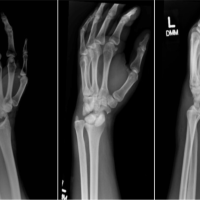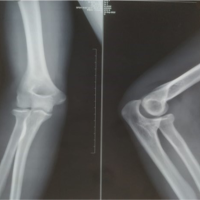[box type=”bio”] What to Learn from this Article?[/box]
Unusual Rare Complex Forearm Injury with its Management.
Case Report | Volume 4 | Issue 2 | JOCR April-June 2014 | Page 13-16 | Shivanna D, Aski B, Manjunath D, Bhatnagar A. DOI: 10.13107/jocr.2250-0685.159
Authors: Shivanna D[1], Aski B[2], Manjunath D[1], Bhatnagar A[3]
[1] Bangalore Medical College and Research Institute. Bangalore, Karnataka, India.
[2] Srinivas Institute of Medical Sciences and Research Centre, Mukka, Mangalore, Karnataka, India.
[3] Fortis Hospital, Mumbai, Maharastra, India.
Address of Correspondence:
Dr. Bahubali Aski. H. No. 407, Staff Quarters, SIMS&RC, Mukka, Mangalore. India. Email : orthoaski@gmail.com
Abstract
Introduction: The injury pattern of open fracture dislocation of elbow with fracture both bones forearm with radial nerve injury is very rare. Very few reports are there in literature related to this kind of injury. However this combination is first of its kind. This rare injury needs special attention by early intervention and biological fixation to achieve good results.
Case Report: A 22 year old female presented to us with history of road traffic accident. On evaluation patient had combination of open fracture dislocation of elbow with open diaphyseal fracture of both forearm bones with radial nerve palsy. The patient was treated in emergency and followed for 2 years.
Conclusion: Open fracture dislocation of elbow is a rare entity. Our case additionally had open fracture both the bones forearm with radial nerve palsy. Early intervention and biological fixation with minimal invasion gives good results in terms of range of movements and patient satisfaction.
Keywords: Complex Elbow Injury, Fracture Dislocation, Radial Nerve Palsy.
Introduction
A ‘complex injury’ of the elbow joint is a fracture and with or without dislocation of the elbow in association with multiple other fractures of the upper extremity, or severe soft tissue trauma, or a concomitant injury to vessels or nerves[1]. These complex injuries should be treated as an emergency. The surgeon should apply any available method that can provide stability to the bone fragments and safe handling of the soft tissues giving priority to internal fixation of the fractures. Severe osseous, soft tissue and neural trauma affect the functional results of the elbow region[2]. This rare injury needs special attention by early intervention and biological fixation to achieve good results.
Case Report
A 22 year old female patient, tailor by occupation came to emergency department with history of road traffic accident and injury sustained to her right elbow and forearm. On examination there was type 3B open fracture having wound over the lateral side of elbow with fractured lateral epicondyle, extensive lacerated wound over the dorsum of proximal 1/3rdforearm with open diaphyseal fracture of both ulna and radius in middle 3rd. On assessment of distal neurovascular deficits, patient found to have low radial nerve palsy with intact vascularity. Standard anteroposterior(AP) and lateral Radiographs were taken which showed lateral epicondylar fracture of humerus with posteromedial dislocation of elbow [Fig. 1] and diaphyseal fracture of both ulna and radius at middle 3rd level [Fig.2]. Tetanus toxoid, antibiotics after test dose along with analgesics were given. After primary wound toilet at emergency, case was posted to emergency operation (2hours since injury) with plan of wound debridement and open reduction and internal fiation/external fixation with minimal possible implants aiming biological fixation and radial nerve exploration. In the operation theatre the elbow was examined under general anaesthesia where no other findings were found except for lateral laxity tested by varus stress test after elbow was reduced. Primary wound debridement with excision of contaminated small lateral epicondylar fragment was done. The radius was fixed with rush pin and ulna was checked, where it was well reduced and in alignment. In view of post traumatic raw area, external fixator pins over the ulna spanning the elbow was planned on table and same was done [Fig. 3]. Then radial nerve was explored utilising the wound and posterior approach where no obvious findings were found. Post operatively antibiotics and analgesics continued. Limb kept elevated for 2 days. Wound debridement was done every 2nd day and posted to operation theater after a week for wound coverage with split skin graft. Post op 5th day wound inspection showed well taken graft and no infection was found [Fig. 4]. After 2 weeks, pins of humerus were taken out and elbow physiotherapy started and patient was discharged. After 2 months, pins of ulna taken out when she had 400 to 1200 of flexion and 600-600 of supination- pronation movements. After 4months, check X ray [Fig. 5 and 6] was taken which showed union of forearm bones when pin was removed and all activities were encouraged except for lifting heavy weight. Range of motion by 6 months were 300-1400 flexion [Fig 7 and 8], 700-800 supination –pronation. Patient followed for 2 years.
Discussion
Regel et al defined a complex injury of the elbow joint as a fracture and with or without dislocation of the elbow in association with multiple other fractures of the upper extremity, or a severe soft tissue trauma, or a concomitant injury to vessels or nerves [1]. Our case had open elbow dislocation with lateral epicondylar fracture with lateral laxity associated radial nerve palsy and associated open fracture both bones of forearm in middle3rd. These complex injuries should be treated as an emergency. The surgeon should apply any available method that can provide stability to the bone fragments and safe handling of the soft tissues giving priority to internal fixation of the fractures. Severe osseous, soft tissue and neural trauma affect the functional results of the elbow region[2].We followed principle of biological fixation and early soft tissue cover. Early coverage of the open wounds about the elbow by flaps or skin grafts is recommended in order to provide wound closure, decrease infection and tissue oedema and allow early mobilization of the elbow joint[3]. We initiated elbow range of motion by the end of 2nd week, which resulted in fairly good range of motion at the subsequent follow ups. This rare injury of radius and ulnar shaft fractures with elbow posterior dislocation has been described as a unique Monteggia-equivalent injury. The postulated mechanism of injury in these injuries is the initial elbow dislocation as a result of the fall on the outstretched arm. Then, both the bones of the forearm fractured while the elbow was in extension, the forearm in hyper-pronation and the wrist in radial deviation. It is unlikely for the elbow dislocation to follow fractures of both the forearm bones [4,5]. In managing such a complex elbow fracture-dislocation, there must be due consideration for restoration of joint congruity, skeletal stabilization as well as ligamentous reconstruction with careful handling of soft tissues around the elbow joint. As such, a combined single stage approach for radius and ulnar shaft stabilization with joint reduction and collateral ligament reconstruction may be useful [5]. There is little evidence in the literature that operative repair of the collateral ligaments has significant advantage over nonsurgical treatment in a plaster cast. For surgical treatment of the collateral ligaments, medial collateral ligament reconstruction is particularly indicated when there is residual instability following lateral ligament reconstruction or in throwing athletes [6]. We choose to fix ulna and radius, reduce elbow and stabilise. When assessed for ligament laxity elbow found to be stable. Patient did not undergo any of the ligament repair. The rotational stability of fractures of the radius and ulna treated with Rush pins and/or fracture bracing was studied in six fresh cadaver forearms rotation and fracture site motion (rotation) were measured as functions of applied forearm torque and rotation (pronation- supination). When loading to specific torque levels, the brace reduced fracture site motion to one-half the motion with no fixation treatment. Under both loading conditions, Rush pin fixation significantly and markedly reduced the fracture site motion (to approximately one eighth of the motion with no fixation treatment), whereas a brace in conjunction with Rush pins did not significantly further reduce the fracture site motion[7]. In our case rush pin for radius with external fixator for ulna significantly reduced fracture site motion and helped in union. In a study by Morrey et al., showed that most of the activities of daily living could be accomplished with a 100° aArc of motion (from 30° to 130°)and 100° of forearm rotation (50° of pronation and 50° of supination)[8]. Our patient achieved 1100 arc of motion (300 to 1400) and forearm rotation of 1500 (700 pronation to 800 supination). Limitations: The implants used for reconstruction are not ones that are up to recommended standards. However the principle of early intervention and biological fixation can be generalized for these rare injuries which may give good reproducible results.
Conclusion
The open fracture dislocation of elbow with open fracture both bones forearm with radial nerve injury is a rare combination. Early intervention and biological fixation with minimal invasion gives good results in terms of range of movements and patient satisfaction.
References
1. Regel G, Seekamp A, Blauth M, Klemme R, Kuhn K, Tscherne H. [Complex injury of the elbow joint]. Unfallchirurg. 1996 Feb;99(2):92-99. Review. German. PubMed PMID: 8881223.
2. Kazakos CJ, Galanis VG, Verettas DA, Dimitrakopoulou A, Polychronidis A, Simopoulos C. Unusual patterns of Monteggia fracture-dislocation. J Orthop Surg Res. 2006 Nov 3;1:12. PubMed PMID: 17150119; PubMed Central PMCID: PMC1636036.
3. Pederson WC, Sanders WE: Bone and soft-tissue reconstruction. Rockwood and Green’s Fractures in adults 4th edition. Editedby: Rockwood CA Jr, Green DP, Bucholz RW, Heckman JD. Philadelphia,Lippincott-Raven; 1996:387-388.
4. Kose O, Durakbasa MO, Islam NC. Posterolateral elbow dislocation with ipsilateral radial and ulnar diaphyseal fractures: a case report. J Orthop Surg (Hong Kong). 2008 Apr;16(1):122-3. PubMed PMID: 18453676.
5. Ramesh S, Lim YJ. Complex elbow dislocation associated with radial and ulnar diaphyseal fractures: a rare combination. Strategies Trauma Limb Reconstr. 2011 Aug;6(2):97-101. doi: 10.1007/s11751-011-0112-5. Epub 2011 Jul 20. PubMed PMID: 21773776; PubMed Central PMCID: PMC3150645.
6. Josefsson PO, Gentz CF, Johnell O, Wendeberg B. Surgical versus non-surgical treatment of ligamentous injuries following dislocation of the elbow joint. A prospective randomized study. J Bone Joint Surg Am. 1987 Apr;69(4):605-8. PubMed PMID: 3571318.
7. Ono M, Bechtold JE, Merkow RL, Sherman RE, Gustilo RB. Rotational stability of diaphyseal fractures of the radius and ulna fixed with Rush pins and/or fracture bracing. Clin Orthop Relat Res. 1989 Mar;(240):236-43. PubMed PMID: 2917439.
8. Morrey BF, Askew LJ, Chao EY. A biomechanical study of normal functional elbow motion. J Bone Joint Surg Am. 1981 Jul;63(6):872-7. PubMed PMID: 7240327.
| How to Cite This Article: Shivanna D, Aski B, Manjunath D, Bhatnagar A. A Rare Combination Open Fracture Dislocation of Elbow with Open Fracture both Bones Forearm with Radial Nerve Palsy. Journal of Orthopaedic Case Reports 2014 April-June;4(2): 13-16. Available from: https://www.jocr.co.in/wp/2014/01/11/2250-0685-147-fulltext/ |
(Figure1)|(Figure2)|(Figure3)|(Figure4)|(Figure5)|(Figure6)|(Figure7)|(Figure8)
[Abstract] [Full Text HTML] [Full Text PDF] [XML]
[rate_this_page]
Dear Reader, We are very excited about New Features in JOCR. Please do let us know what you think by Clicking on the Sliding “Feedback Form” button on the <<< left of the page or sending a mail to us at editor.jocr@gmail.com




